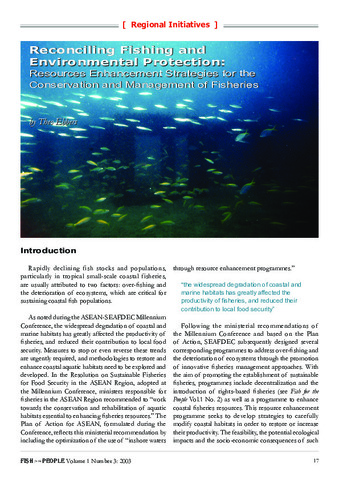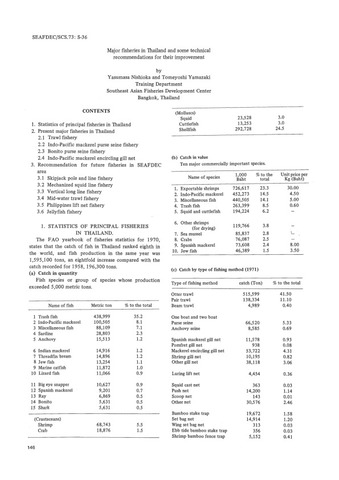Reconciling fishing and environmental protection: Resources enhancement strategies for the conservation and management of fisheries
Share
abstrak
The article is a reflection of the discussion and the results of a regional workshop conducted by the SEAFDEC (Southeast Asian Fisheries Development Center) Training Department in which the methodologies and techniques for resource enhancement suggested at the Millennium Conference (artificial reefs, the stationary fishing gear, the restocking programmes and marine protected areas) were discussed. The article deals with the various resource enhancement strategies that were suggested and discussed.
Suggested Citation
Ebbers, T. (2003). Reconciling fishing and environmental protection: Resources enhancement strategies for the conservation and management of fisheries. Fish for the People , 1(3), 17-26. http://hdl.handle.net/20.500.12066/675
Subjek
Koleksi
Related items
Showing items related by title, author, creator and subject.
-
The Status of Fisheries in the Republic of Maldives
Faiz, Mohamed (Training Department, Southeast Asian Fisheries Development Center, 1997)The paper discusses the tuna fisheries in Maldives which dominates its fishing industry. Apart from a very strong domestic market, tuna is also the main export commodity of the country. Moreover, reef fisheries such as, ... -
Major fisheries in Thailand and some technical recommendations for their improvement
Nishioka, Yasumasa; Yamazaki, Tomeyoshi (Japan International Cooperation Agency, 1977)Presented in this paper is the development of fisheries industry in Thailand. The data on the production of the principal fisheries species and major fishing methods are also presented. Also included are the recommendations ... -
Status of Fishing Conditions in Cambodia
Sour, Kim; Vuthy, Ros (Training Department, Southeast Asian Fisheries Development Center, 1997)Fisheries in plays a very important role in Cambodia’s national economic development. Total fish catch production in 1996 was 104 310 tones, about which 60% was contributed by inland capture fisheries, 30% by marine capture ...





